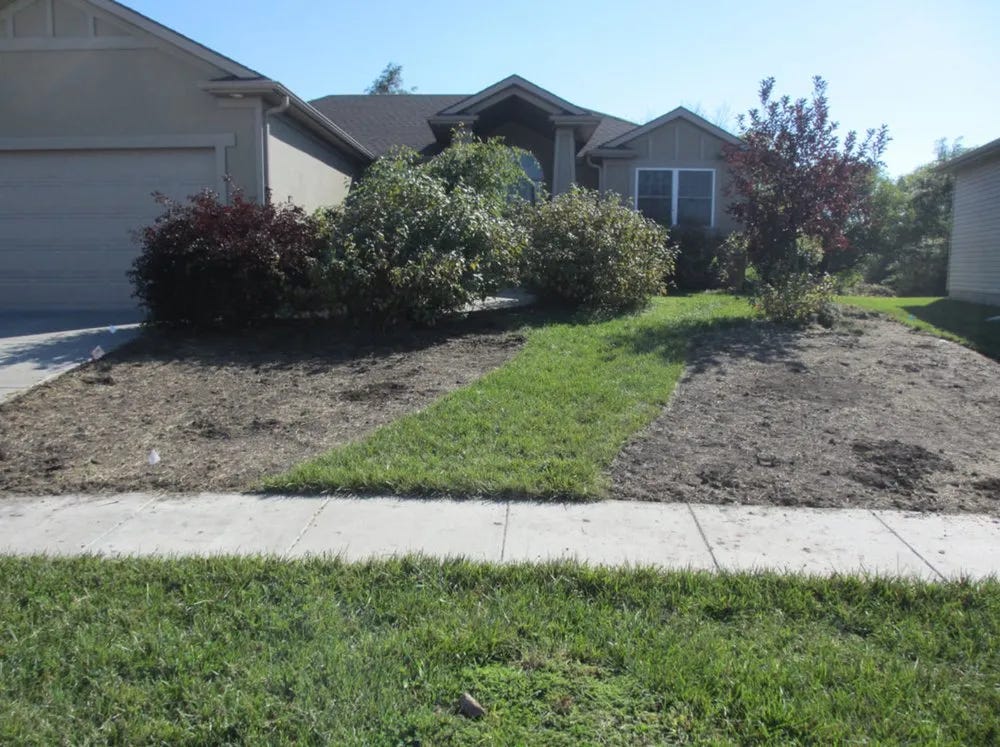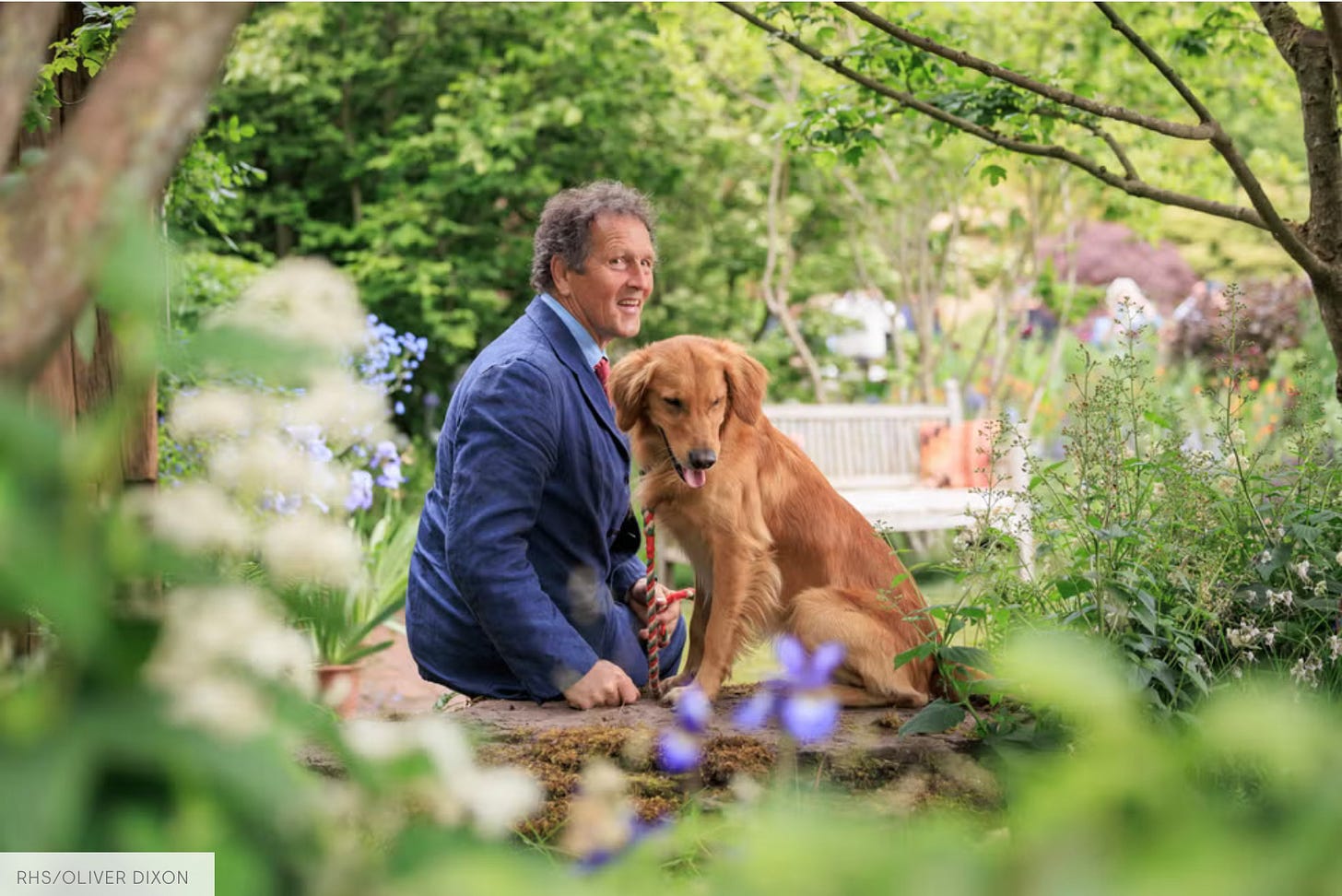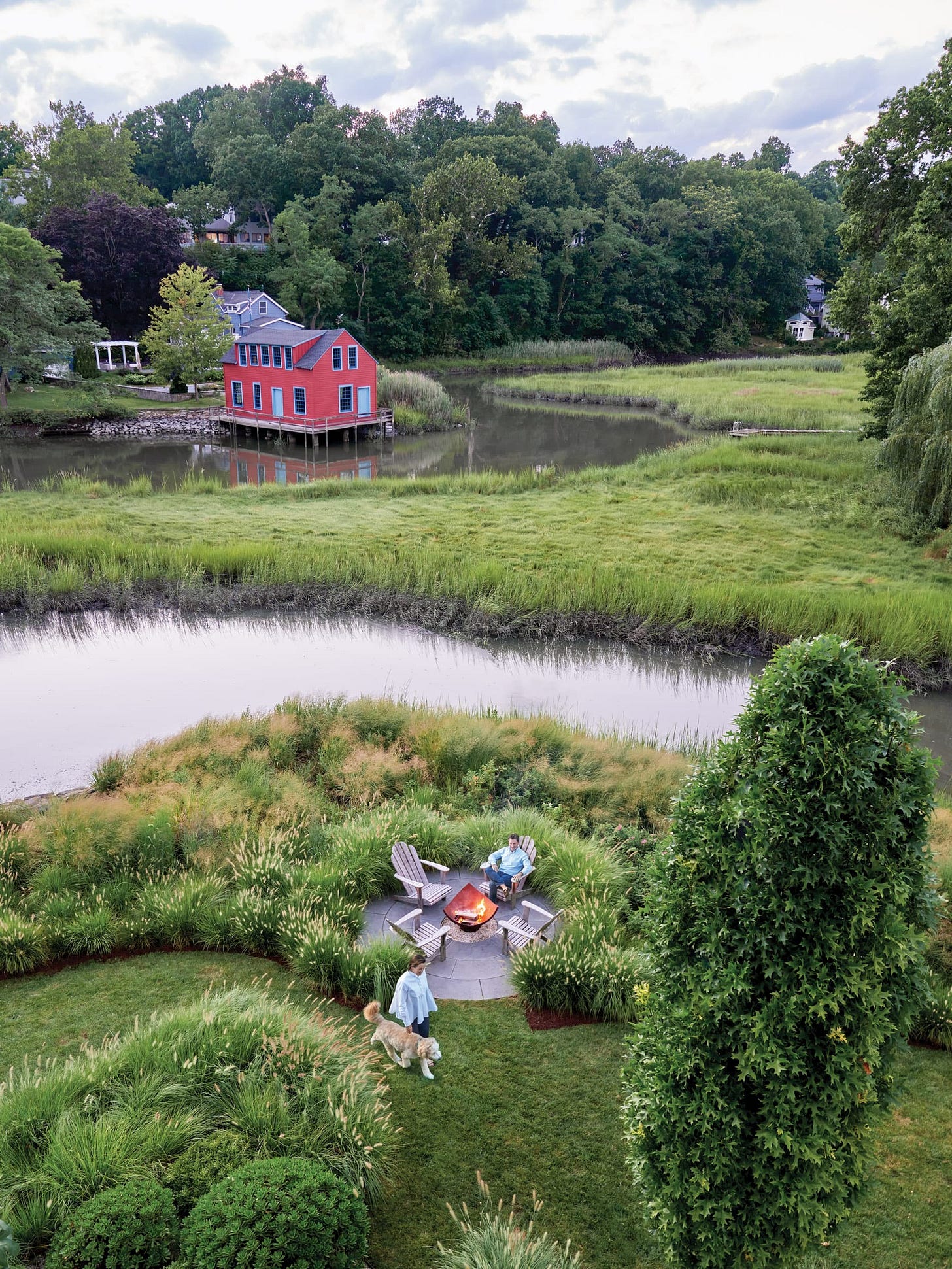Snappy Answers to 17 Common Questions
From navigating getting started overwhelm to fielding common challenges.

Dear Superb Subscribers,
It’s almost time for our late summer workshop series and many great questions from the spring series remain unanswered. My apologies to those awaiting a response. Fortunately, I had touched on most topics previously, so here are snappy answers to 17 questions with links to prior newsletters for deeper dives.
Getting started: paths and destinations
We just moved to this house last June. I don't want to get overwhelmed. Would you suggest just starting with one or two destinations this year? — Rosemary
Yes. Think big, but act only on what you can manage. The benefit of an overall plan or layout is knowing how your initial plantings will eventually fit into the whole. One definitional quibble: Remember that your plantings are not paths and destinations; they are the walls — gorgeous, layered, decorative walls — around your paths and destinations.
Fall is an optimal time to plant shrubs and trees in much of the country, so your first plantings might be a tapestry hedge for privacy or to blur the boundary defined by a backyard fence. Or it could be a perennial bed that will eventually line part of a path or destination. For an intro to overall plans of paths and destinations, see Dream Big Now! And 5 Design Questions Answered; for first planting ideas, see How to Get Started.
Can you talk about front yard solutions? How can one transform a traditional front walk and foundation border into a somewhat wild area? — Daryl
If you have the chutzpah, the easiest, cheapest solution is to seed much of the existing turf this fall per the instructions here. Many people — including me — feel embarrassed that their yards look more messy than wild for three years while the meadow grows in. Leaving a verge of turf is a “cue to care” that helps. So does mowing the entire meadow in spring to tame any rangy cold-season turf grasses that remain and jumpstarting blooms by planting plugs and plants into your meadow.
See How to Get Started for less brazen approaches like planting a pollinator patch, a privacy hedge, or even a single native tree with a “pupation station” underneath. Whatever method you choose to go wild, I recommend leaving existing turf for a front yard seating area (a destination) and a path to stroll around your house or, if the backyard isn’t connected, just around the front yard.


What if many areas where I want to place paths and destinations are not turf, but Vinca, Oriental Bittersweet, and English Ivy? I’ve already removed a good bit of that for native beds, but there’s a lot left. — Donna, South Jersey
Kudos for tackling that mess! If you want grassy paths and destinations, you can replace those invasives with aggressive, low-growing natives that tolerate foot traffic. The good news is that you may avoid mowing while adding more ecological value compared to traditional turf. Options, ranked roughly by ecological value, include wild strawberry, Pennsylvania sedge, native violets, American self heal, and white clover. I wrote about these options in more detail in The New American Lawn. A non-native option worth considering is an eco-lawn like this one from Eartheasy.
Of course, you can also hardscape the paths and destinations reclaimed from invasives. Woodchips (especially in shade) and gravel are inexpensive, permeable options, followed by brick and pavers. All can be done DIY. However, it’s important to note that hardscaping requires maintenance. For example, except in the driest climates, all sorts of things seed INTO gravel from above (more than below), so you have to weed it regularly. And hardscaping has no ecological value.
Does it make sense to have a small lawn area in the middle of the big yard but only connected by one path? Does it need to connect to the full circle path? — Serena, Silver Spring, MD
Hmmm, no? My hope for you is that you – and your family and friends, if you like — enjoy your entire yard. If you’ve got a big yard, I imagine you’ll have various destinations to draw you out into it, with a series of paths connecting them. Perhaps I wasn’t clear when I emphasized one main path for frequent strolls around your home; the point of this is to create an interesting route for daily walks, with subsidiary paths to specific destinations (e.g., a compost heap) or for longer walks on larger properties.
So, please consider several seating areas, for a start, keeping in mind you can vary the experience of each by situating them in sun or shade, and varying the planting schemes and type of seating. To help spur your imagination for other destinations, check out the images in our Pinterest boards for Choices (destinations) and Comfort (seating).
Zoe, do you mind sharing which edible berries you've added? — Kate
Zoe and I love berries — easy to grow, great for wildlife, and tasty when you can get one before the birds do. We have found berries to be the easiest way to incorporate taste, part of the seventh attribute of a restorative garden: stimulating all the senses. Zoe and I both grow elderberries, highbush blueberries, wild strawberries, Allegheny blackberries, and flowering raspberries. I also have beach plums, black cherries, and one serviceberry — a popular tree thanks to Robin Wall Kimmerer’s bestselling book. (Unfortunately, serviceberries are susceptible to cedar-apple rust, a problem in suburban neighborhoods like mine with a lot of arborvitae and red cedars.) You can see range maps and details in Five Fabulous Fruits. And here’s a checklist to compare your yard against all 10 design attributes of a restorative garden.
Pets, pests, and other problems
Any ideas for what to do for early afternoon dinner parties in a big garden with lots of mosquitoes? I mean a lot of mosquitoes! — Melissa, Bethesda, MD
Aren’t mosquitoes a buzz kill? I receive so many mosquito questions from readers that I visited a Gainesville lab run by the USDA, which invented DEET. My top recommendations for your dinner parties are standing fans, an all-white dress code, a basket with a selection of repellants, and, under the table, mosquito repellent coils in holders. If that’s not enough, get a portable screen house. For detailed mosquito-fighting intel and advice from my lab visit, read Avoid Mosquito Bites in Your Yard. (And here’s an interesting article about the possibility and ethics of using gene editing to eliminate mosquitoes.)
My birddog spends a lot of time in the yard and doesn’t respect planted areas; in fact, a meadow is a great place to find critters. What strategies can I use to wild my yard without ending up with trashed areas? A dog run isn’t an option. — L
Dogs have such personalities, so each dog-friendly landscape will be different, designed around his or her unique habits and temperament. From your brief description, I’m imagining a large, rambunctious dog tearing through a meadow after a rabbit, leaving a trail of trampled plants in his wake. Such trampling is disastrous for tall perennials that tend to flop over anyway. For plants that withstand such enthusiastic play, look for locally-native shrubs, trees, and tough, low-growing groundcovers. If you already have tall meadow plants, try using the Chelsea chop to keep them shorter and stronger or consider enclosing some plants, instead of the dog.

How do you deal with wanting a cutting garden and having a small amount of space and a dog? — Amy
How small is small? According to Trulia, the average American lot is about 14,000 square feet, with about a quarter of an acre of yard and 2,400 square feet for the house’s footprint. This typical lot varies widely by state — and not how I’d expect, with yards in Vermont averaging ten times the size of those in Nevada. (See the median lot size in your state here.)
If you have room, you can fence your cutting garden to protect it from your dog, as well as from rabbits and deer. From a design standpoint, fencing cutting and vegetable gardens signals why they are planted in rows, rather than more naturalistically. If you have a really small garden, see This Is How to Make Small Awesome and grow your precious plants in containers.
I would like to know about ways to reduce noise in outdoor space, via landscaping. There are lots of dogs in my neighborhood and someone is always mowing their lawn. It tends to drive me back inside because it's distracting. How can I reduce the noise level? — Elizabeth, Ithaka, NY
Grrrr, mowers and blowers! Research proves dense plantings deaden sound, so keep on planting on. For the science of planting for noise, read What? I Can’t Hear You!
Unfortunately, you probably don’t have enough room for plantings to completely absorb the nearby barking and lawn equipment. Adding a pleasantly tinkling fountain and planting quaking aspens may distract you from the noise while supporting wildlife. Monitoring your neighbor’s schedules and inventing ways to enjoy your yard when they are least likely to be out is another. In the meantime, you can reclaim your yard by wearing comfortable noise-cancelling headphones like the soundcore Space One Pete just bought me.
You said ticks have plants they don’t like. What kind of plants? — Jennifer
Ticks avoid mints like native monardas and mountain mints — beautiful, easy-to-grow plant families. To learn about Zoe’s anti-tick border and other strategies she used to dramatically reduce the number of ticks in her yard, see How to Protect Yourself from Lyme Disease If You Love Wildlife.
Do you have any deer-resistant thoughts? — R
Too many deer thoughts for a snappy answer, unfortunately. Deer tastes seem to vary from place to place, but they’ll eat anything if they are hungry enough. And male rutting in winter snaps young trees that they don’t even eat. So if many deer visit your yard, I recommend temporary fencing for shrubs and trees as they establish; we take down our temporary fencing in summer and Pete applies minty-smelling Deer Out every couple of weeks. Read more about protecting plants from deer in Keep Your Plants Safe.
Water and sewage
Our backyard slopes steeply down toward our house, so our basement floods after a heavy rain. What do you recommend? — SB, Hudson Valley, NY
Replacing turf with native plants, which have much deeper roots, solves minor water intrusion issues, as it has at our house. However, with your steep slope, I suggest catching the water in a rain garden before it reaches your foundation. A rain garden is simply a depression deep enough to hold a storm’s worth of water, often only inches deep. You can find instructions and plant lists for your region in the Mountain Top Arboretum’s Education Center Rain Gardens Guide. After digging the depression, you can plant plugs once the worst summer heat has passed (e.g., from Izel) or direct seed in late fall. Install temporary fencing to keep out deer and rabbits while the plants establish. (See my list of plants easy to grow from direct sowing.)
Unfortunately, one of the main areas we want privacy is near our septic. Would it be crazy to plant trees or shrubs near that? — Rosemary
Yes, do not plant trees or shrubs over a septic field. Their roots may interfere with the distribution system. However, you can plant a tall meadow that will give you some privacy – and also improve the functioning of your system. Look for a locally native mix like Prairie Moon’s Septic Safe Mix (or plant any of its components). Here’s my deeper dive into Septic Safe Planting.

Yardenality (aka style), furniture, and hardscaping
Does house architecture need to be considered too? — Cat, Hudson Valley, NY
Considered, yes. Governed by, no. Historically, some architectural styles have been paired with certain Yardenalities, so they look natural together. Here are some of these pairings:
Colonial → A Walk in the Park
Industrial and modern → Prairie Modern
Mediterranean → California Dreamin’
Stone or brick → Courtyard Chic
Victorian and arts and crafts → Blooming Romantic
If you have a beloved garden style that doesn’t naturally work with your house’s architecture, I recommend choosing hardscaping and furniture that works with both the architectural style and the Yardenality. For example, if you want a pink-and-white Blooming Romantic garden and have an industrial modern house, skip the Victorian cast iron benches and planters in favor of crisp, geometric ones, then go crazy with the native roses and climbing hydrangea.
What about destinations and furniture for the A Walk in the Park Yardenality? — Linda, Baltimore, MD
Funny, I think of destinations as independent of garden style. They are rooms where you want to spend time. That said, A Walk in the Park is the most naturalistic style, so it brings to mind destinations like rock or log council circles or stump-and-woodchip play areas. As for furniture, wood – unfinished or painted dark green – is the most characteristic furniture choice for A Walk in the Park. Local stone or modern styles work, too. Most important is to limit the number of materials and aim for stylistic consistency. (For ideas, see our A Walk in the Park Pinterest board.)
How do you deal with shaded areas (dining and seating) and bird droppings? — Amy
Pick furniture that is easy to clean (natural wood, painted wood or metal, glass table tops) and plan to wipe it off occasionally. However, I disregarded this advice myself when I tucked our newly upholstered sofa under a legacy Japanese viburnum. It’s just the perfect place to sit and have a drink in the early evening! I picked a Sunbrella animal print that hides stains and plan to spot clean it as necessary. In the meantime, I brush it off each evening with a brush hidden behind the tree. (For more tips, see my newsletter on the dirty downside of today’s outdoor furniture.)
Future learning
Will you be doing more workshops? So we can keep learning. — Marsha
Yes, we will soon be announcing our late summer workshops for paying subscribers. Please let me know in the comments section below if there’s a topic you’d like us to cover.
Hope to see you all on Zoom soon!
— Heather




Joe from Growing a greener world has this fantastic video about killing the mosquitoes reproductive cycle and sounds like an effective method. Essentially it involves these mosquito dunks that contain BT. People in the comments seem to like it - I don’t have a mosquito issue and haven’t tested it as such. The link is here - https://youtu.be/FYZigrfYnuY?si=opk3NHDik4nux6VF